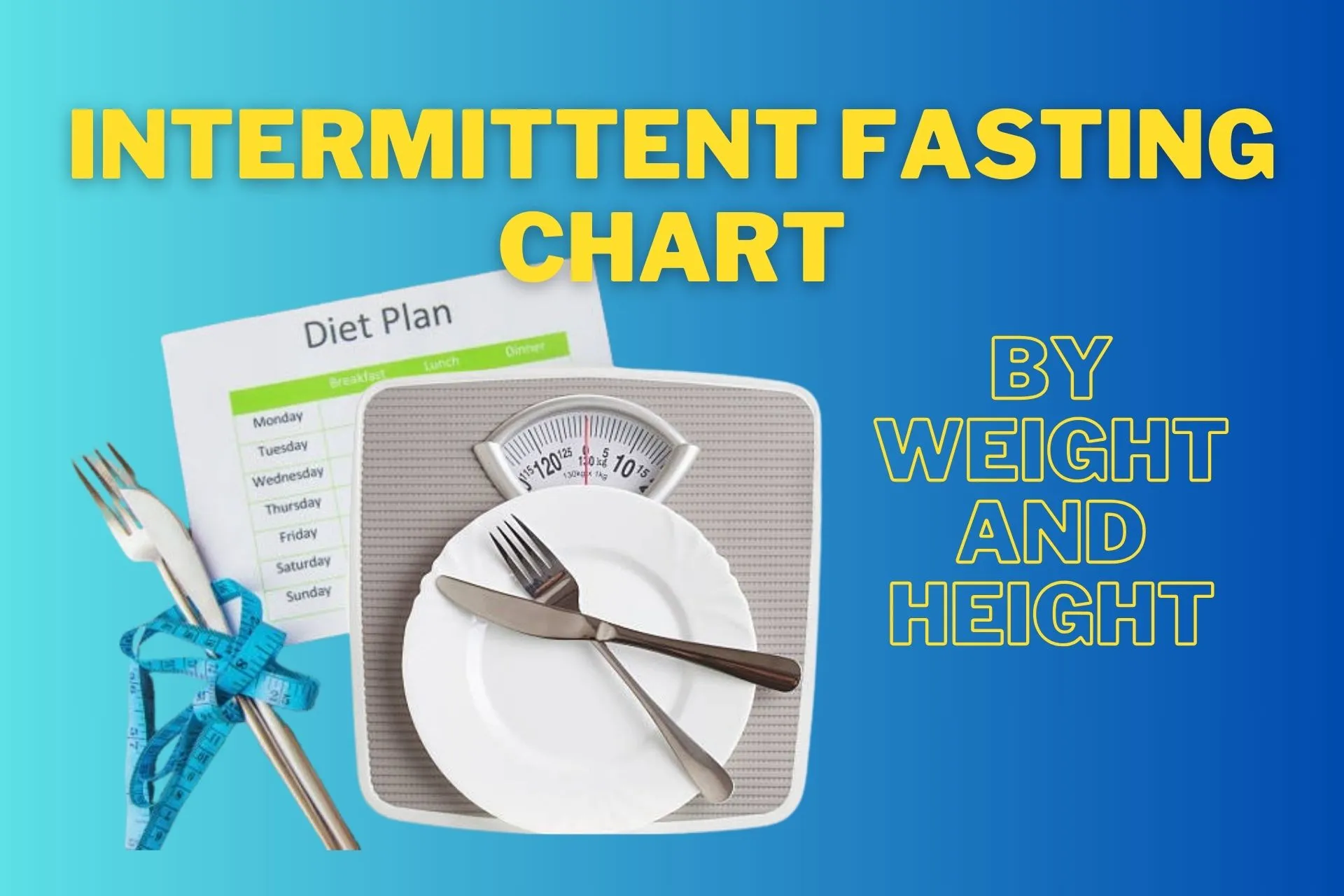Intermittent Fasting Chart By Weight And Height
Intermittent fasting chart by weight and height
Intermittent fasting is a popular diet trend that has gained widespread popularity in recent years. It involves alternating periods of eating and fasting, with the goal of improving overall health and promoting weight loss. One of the key factors that determine the success of intermittent fasting is the individual’s weight and height. In this article, we will discuss the intermittent fasting chart by weight and height, and how it can help you achieve your health and weight loss goals.
Table of Contents
What is Intermittent Fasting?

Intermittent fasting is a dietary approach that involves alternating periods of eating and fasting. There are several different methods of intermittent fasting, including time-restricted feeding, alternate-day fasting, and the 5:2 diet.
The goal of intermittent fasting is to improve overall health, promote weight loss, and enhance mental clarity and focus.
How Does Intermittent Fasting Work?
Intermittent fasting works by restricting the amount of time that you eat, which in turn restricts the amount of calories that you consume. This can lead to a calorie deficit, which can result in weight loss.
Additionally, intermittent fasting can improve insulin sensitivity, reduce inflammation, and promote cellular repair and rejuvenation.
Intermittent Fasting Chart by Weight and Height
The intermittent fasting chart by weight and height is a tool that can help you determine the best fasting schedule for your body type. It takes into account your weight and height to determine the optimal fasting window and calorie intake.
For example, if you are a woman who is 5’5″ and weighs 150 pounds, your optimal fasting window might be 16 hours, with an eating window of 8 hours. This means that you would fast for 16 hours and eat during an 8-hour window.
On the other hand, if you are a man who is 6’2″ and weighs 200 pounds, your optimal fasting window might be 18 hours, with an eating window of 6 hours. This means that you would fast for 18 hours and eat during a 6-hour window.
It is important to note that the intermittent fasting chart by weight and height is just a guideline, and individual results may vary. It is always recommended to consult with a healthcare professional before starting any new diet or exercise program.
Benefits of Intermittent Fasting

Intermittent fasting has numerous health benefits, including:
1. Weight Loss: Intermittent fasting can help you lose weight by restricting the amount of time that you eat, which in turn restricts the amount of calories that you consume.
2. Improved Insulin Sensitivity: Intermittent fasting can improve insulin sensitivity, which can help regulate blood sugar levels and reduce the risk of developing type 2 diabetes.
3. Reduced Inflammation: Intermittent fasting can reduce inflammation in the body, which can help reduce the risk of chronic diseases such as heart disease and cancer.
4. Enhanced Mental Clarity and Focus: Intermittent fasting can improve mental clarity and focus, which can help improve productivity and overall cognitive function.
5. Cellular Repair and Rejuvenation: Intermittent fasting can promote cellular repair and rejuvenation, which can help improve overall health and longevity.
Best Supplement To Lose Belly Fat: Must Read
How To Create An Intermittent Fasting Chart For Weight And Height
To create an intermittent fasting chart based on weight and height, you can follow these steps:
1. Determine Your Optimal Fasting Window:
- Calculate your Body Mass Index (BMI) using your weight and height.
- Consider popular intermittent fasting schedules like the 16:8 method (fasting for 16 hours and eating within an 8-hour window), the 5:2 method (eating regularly five days a week and fasting two days), or the Warrior Diet (eating one large meal within a 4-hour window).
- Choose a fasting schedule that aligns with your lifestyle and preferences.
2. Customize Your Fasting Plan:
- Tailor your fasting window based on your BMI, weight loss goals, and daily routine.
- Adjust the fasting and eating windows to suit your health status, goals, and comfort level.
- Ensure you are consuming adequate nutrients during your eating window to support overall health.
3. Monitor Your Progress:
- Regularly track your weight, energy levels, and overall well-being to assess the effectiveness of your fasting plan.
- Be prepared to make adjustments to your fasting schedule as needed for optimal results.
4. Seek Professional Guidance:
- Consult with a healthcare provider or a registered dietitian before starting any new fasting regimen, especially if you have underlying health conditions or specific dietary needs.
- Consider age-specific guidance if available, as our bodies’ responses to fasting can vary with age.
Remember, intermittent fasting should be personalized to suit your individual needs and preferences. It’s essential to listen to your body, stay consistent with your plan, and prioritize overall health and well-being throughout the process.
How To Track Weight And Height Changes During Intermittent Fasting
To effectively track weight and height changes during intermittent fasting, consider the following methods outlined in the search results:
1. Measure Your Waist:
– Measuring your waist can be a more reliable indicator of fat loss than just weighing yourself. Visceral fat around internal organs is a critical area to monitor for health reasons.
– Ensure your waist measures less than half of your height for optimal health benefits.
– Use a tape measure to measure your natural waist, about halfway between your navel and ribs, consistently to track changes accurately.
2. Weigh Yourself Daily and Take an Average:
– Weighing yourself daily and calculating an average weight over several days can provide a more accurate picture of weight changes.
– Daily weighing helps you understand fluctuations due to factors like water retention, hormonal changes, and food intake variations.
– Taking an average helps smooth out daily fluctuations and provides a more reliable trend of weight loss progress.
3. Understand the Limitations of Weighing Alone:
– Weight fluctuations can be significant due to factors like water retention, hormonal changes, and muscle damage from exercise.
– Weighing once a week may not capture the full picture of your weight loss journey due to daily variations.
– Consider other methods like measuring your waist and tracking daily weight changes to complement traditional weighing practices.
4. Utilize Body Measurements:
– Measuring different parts of your body, such as waist, hips, thighs, and arms, can provide a comprehensive view of fat loss and muscle gain.
– Body measurements can help you track changes in specific areas even when overall weight remains stable.
– Use a simple tape measure to monitor changes in body measurements over time.
By incorporating these methods into your intermittent fasting routine, you can gain a more holistic view of your progress beyond just relying on the number on the scale. Remember that individual responses to fasting may vary, so it’s essential to find tracking methods that work best for you and align with your health goals.
What Are Some Apps That Can Help Track Weight And Height Changes During Intermittent Fasting
There are several apps available that can help you track weight and height changes during intermittent fasting. Here are some top picks:
1. Zero: Zero is a popular intermittent fasting app that offers a fasting tracker, hydration tracking, and healthy recipes. It allows you to set your own fasting schedule and track your progress over time.
2. DoFasting: DoFasting is an app designed for both beginners and experienced intermittent fasters. It offers a fasting tracker, water and calorie intake monitoring, and personalized fasting tips and tricks. The app also provides educational articles and over 5000 recipes to help you maintain a healthy diet.
3. BodyFast: BodyFast is a Germany-based app that offers customizable fasting plans and a meal planning feature. It allows you to track your weight changes, calories, and water consumption, and even offers weekly challenges to keep you motivated.
4. LIFE Fasting Tracker: LIFE Fasting Tracker is a scheduling tracker app that allows you to set your own start and end times for fasting periods. It also provides in-app learning libraries with research-based articles and tips for beginners.
5. Vora: Vora is a simple intermittent fasting app that focuses on meal time tracking. It doesn’t offer many other weight loss tools, but it can be useful for tracking your fasting periods and meal times. These apps can help you stay on track with your intermittent fasting routine and monitor your weight and height changes over time. Remember to consult with your healthcare provider before starting any new diet program, including intermittent fasting.
What Are Some Common Mistakes To Avoid When Measuring Weight And Height During Intermittent Fasting
When measuring weight and height during intermittent fasting, there are some common mistakes to avoid:
1. Not Easing into It: Skipping meals and suddenly shrinking your eating window can lead to feelings of constant hunger and discouragement. Instead, gradually reduce your eating window and pay attention to your body’s hunger cues.
2. Consuming Too Many Calories: Intermittent fasting is about when you eat, not how much. Make sure you’re not overeating during your eating window. Focus on nutrient-dense foods like fruits, vegetables, and lean proteins.
3. Not Eating Enough: Undereating can lead to muscle loss, a slower metabolism, and fatigue. Make sure you’re consuming enough calories and protein to support your body’s needs.
4. Eating Too Much When Breaking Your Fast: Hunger after a fast is normal, but overeating can offset any weight loss achieved. Stick to nutritious, balanced meals during your eating window.
5. Ignoring Hydration: Staying hydrated is essential for overall health and can help with weight loss. Make sure you’re drinking enough water throughout the day.
6. Being Too Rigid: Intermittent fasting should be flexible and adapt to your lifestyle. Don’t beat yourself up if you eat outside your fasting period. Listen to your body and make adjustments as needed.
Remember, the goal of intermittent fasting is to improve overall health and well-being. Avoid these common mistakes and focus on creating a sustainable, healthy eating pattern that works for you.
Healthy Meal Options for Intermittent Fasting
Intermittent fasting offers flexibility in food choices, focusing on nutrient-dense whole foods that can be incorporated into your meal plan during your eating windows. Here are some healthy meal options for intermittent fasting:
1. Proteins: 2. Healthy Fats 3. Vegetables 4. Fruits: 5. Whole Grains 6. Dairy and Lean Proteins 7. Fermented Foods etc.
Conclusion: Intermittent Fasting Chart By Weight And Height
Intermittent fasting is a popular diet trend that has gained widespread popularity in recent years. It involves alternating periods of eating and fasting, with the goal of improving overall health and promoting weight loss.
The intermittent fasting chart by weight and height is a tool that can help you determine the best fasting schedule for your body type, taking into account your weight and height to determine the optimal fasting window and calorie intake.
Intermittent fasting has numerous health benefits, including weight loss, improved insulin sensitivity, reduced inflammation, enhanced mental clarity and focus, and cellular repair and rejuvenation. It is always recommended to consult with a healthcare professional before starting any new diet or exercise program.




